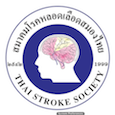OXIDATIVE STRESS IN ACUTE ISCHEMIC STROKE
Abstract
Interruption of focal cerebral blood flow causes ischemic injuries to local brain tissue. The mechanism of ischemic injury, so-call ischemic cascade, is a primary damage. The primary injury leads to tissue necrosis then apoptosis. Secondary injury begins when ischemic tissue is reperfused. This secondary damage adds up the injuries to not only ischemic tissue but also surrounding normal tissue. Oxidative stress plays the major role in reperfusion injury. Neuroprotective therapies that intervened with mechanism of oxidative stress may show beneficial results in treatment of acute ischemic stroke
References
Hanchaiphiboolkul S, Poungvarin N, Nidhinandana S, et al. Prevalence of stroke and stroke risk factors in Thailand: Thai Epidemiologic Stroke (TES) Study.
J Med Assoc Thai 2011;94:427-436.
Go AS, Mozaffarian D, Roger VL, et al. Heart Disease and Stroke Statistics—2014 Update: A Report From the American Heart Association. Circulation
2014;129:e28-e292.
Jauch EC, Saver JL, Adams HP, et al. Guidelines for the Early Management of Patients With Acute Ischemic Stroke: A Guideline for Healthcare Professionals From the American Heart Association/American Stroke Association. Stroke 2013.
Muengtaweepongsa S, Dharmasaroja P, Kummark U. Outcomes of Intravenous Thrombolytic Therapy for Acute Ischemic Stroke With an Integrated Acute
Stroke Referral Network: Initial Experience of a Community-Based Hospital in a Developing Country. Journal of Stroke and Cerebrovascular Diseases
2012;21:42-46.
Fisher M. New approaches to neuroprotective drug development. Stroke 2011;42:S24-S27.
Labiche LA, Grotta JC. Clinical trials for cytoprotection in stroke. NeuroRx 2004;1:46-70.
Gusev EISVI. Brain ischemia. New York: Kluwer Academic/Plenum Publishers; 2003.
GUTIERREZ G. Cellular energy metabolism during hypoxia. Critical care medicine 1991;19:619-626.
Xing C, Arai K, Lo EH, Hommel M. Pathophysiologic cascades in ischemic stroke. Int J Stroke 2012;7:378-385.
Hinkle JL, Bowman L. Neuroprotection for ischemic stroke. The Journal of neuroscience nursing : journal of the American Association of Neuroscience
Nurses 2003;35:114-118.
Hazell AS. Excitotoxic mechanisms in stroke: an update of concepts and treatment strategies. Neurochemistry international 2007;50:941-953.
Aronowski J, Strong R, Grotta JC. Reperfusion injury: demonstration of brain damage produced by reperfusion after transient focal ischemia in rats.
Journal of Cerebral Blood Flow & Metabolism 1997;17:1048-1056.
Iadecola C, Anrather J. The immunology of stroke: from mechanisms to translation. Nature medicine 2011;17:796-808.
Xi G, Keep RF, Hoff JT. Pathophysiology of brain edema formation. Neurosurgery Clinics of North America 2002;13:371-383.
Strbian D, Durukan A, Pitkonen M, et al. The blood–brain barrier is continuously open for several weeks following transient focal cerebral ischemia.
Neuroscience 2008;153:175-181.
Brott T, Bogousslavsky J. Treatment of acute ischemic stroke. N Engl J Med 2000;343:710-722.
Kristián T, Siesjö BK. Calcium in Ischemic Cell Death. Stroke 1998;29:705-18.
Trump B, Berezesky I. Calcium-mediated cell injury and cell death. The FASEB journal 1995;9:219-228.
Allen CL, Bayraktutan U. Oxidative stress and its role in the pathogenesis of ischaemic stroke. International Journal of Stroke 2009;4:461-470.
Nanetti L, Raffaelli F, Vignini A, et al. Oxidative stress in ischaemic stroke. European journal of clinical investigation 2011;41:1318-1322.
Sies H. Oxidative stress: oxidants and antioxidants. Experimental physiology 1997;82:29129-5.
Floyd RA. Antioxidants, oxidative stress, and degenerative neurological disorders. Experimental Biology and Medicine 1999;222:236-245.
Storz G, Imlayt JA. Oxidative stress. Current opinion in microbiology 1999;2:188-194.
Fong JJ, Rhoney DH. NXY-059: review of neuroprotective potential for acute stroke. Annals of Pharmacotherapy 2006;40:461-471.
Fisher M. Recommendations for advancing development of acute stroke therapies stroke therapy academic industry roundtable 3. Stroke 2003;34:1539-
1546.
Lees KR, Zivin JA, Ashwood T, et al. NXY-059 for acute ischemic stroke. New England Journal of Medicine 2006;354:588-600.
Shuaib A, Lees KR, Lyden P, et al. NXY-059 for the Treatment of Acute Ischemic Stroke. New England Journal of Medicine 2007;357:562-571.
Savitz SI. A critical appraisal of the NXY-059 neuroprotection studies for acute stroke: a need for more rigorous testing of neuroprotective agents in animal models of stroke. Experimental neurology 2007;205:20-25.
Feuerstein GZ, Zaleska MM, Krams M, et al. Missing steps in the STAIR case: a Translational Medicine perspective on the development of NXY-059 for treatment of acute ischemic stroke. Journal of Cerebral Blood Flow & Metabolism 2008;28:217-219.
Saver JL, Albers GW, Dunn B, Johnston KC, Fisher M. Stroke Therapy Academic Industry Roundtable (STAIR) recommendations for extended window acute
stroke therapy trials. Stroke 2009;40:2594-2600.
Downloads
Published
How to Cite
Issue
Section
License
ข้อความภายในบทความที่ตีพิมพ์ในวารสารสมาคมโรคหลอดเลือดสมองไทยเล่มนี้ ตลอดจนความรับผิดชอบด้านเนื้อหาและการตรวจร่างบทความเป็นของผู้นิพนธ์ ไม่เกี่ยวข้องกับกองบรรณาธิการแต่อย่างใด การนำเนื้อหา ข้อความหรือข้อคิดเห็นของบทความไปเผยแพร่ ต้องได้รับอนุญาตจากกองบรรณาธิการอย่างเป็นลายลักษณ์อักษร ผลงานที่ได้รับการตีพิมพ์ในวารสารเล่มนี้ถือเป็นลิขสิทธิ์ของวารสาร





